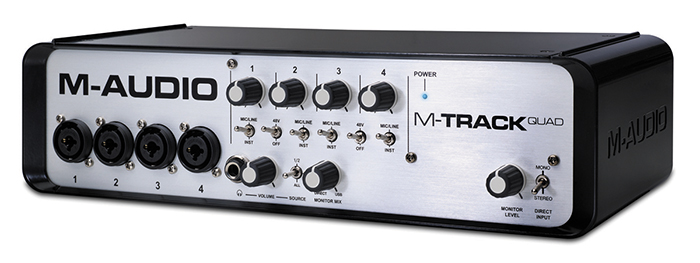
Lets review professional external sound card M-Audio M-Track Quad, which is able to work with sampling rates up to 96 kHz and 24 bits precision. Its frontal panel has : 4 combined XLR/TRS ( 1/4″ jack ) inputs, which can work in mictophone ( there is ability to switch phantom power +48 V for them ), linear and instrumental Hi-Z modes; volume controls for each of them and linear/microphone and instrumental work mode and phantom power switches; TRS ( 1/4″ jack ) output for monitor headphones, Direct Monitor switch, their volume control knob and Direct Monitor source switch ( all channels or only 1st and 2nd ones ); stereo/mono Direct Monitor switch, outputs volume control knob and power and work indicator. Its back panel has : USB port, through which it is powered and communicates with computer, and another 3 ports for external devices plugging in hub mode; 4 analogue TRS ( 1/4″ jack ) outputs; MIDI input and output, power adapter input and power switch button; and 4 TRS ( 1/4″ jack ) insert inputs for effects.

M-Audio M-Track Quad is bundled with AIR Music Technology Ignite software, containing Smart MIDI Chord and Phrase players with 275 sound samples. For it drivers are released for Windows XP, Vista, 7, 8, 8.1 and 10 and Mac OS X 10.7.5 and newer operating systems, with ASIO 2.0 and Core Audio interfaces support, which allow it to work tightly with modern DAWs : Ableton Live, Steinberg Cubase, FL Studio, Cackewalk Sonar, REAPER, Avid Pro Tools and others. Its body is made from metal; sizes are 333 ( width ) x 89 ( height ) x 156 ( depth ) mm. Package contains : M-Audio M-Track Quad sound card itself, USB cable, optical disks with drivers and software, warranty card and user’s guide. From one side : this is a good professional sound card, which allows to work with sound on studio-grade level; from the other : supported maximal sampling rate is not the highest and it does not support balanced inputs and outputs. So, when external audio interface is compared with other similar models ( Behringer, Steinberg, Roland, Focusrite, ESI and other manufacturers ), there is need to look on prices of devices and accordance of technical characteristics to specific task, for which device will be used.



